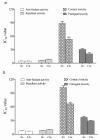Chemical Composition of Cinnamomum verum Leaf and Flower Essential Oils and Analysis of Their Antibacterial, Insecticidal, and Larvicidal Properties
- PMID: 34684884
- PMCID: PMC8537797
- DOI: 10.3390/molecules26206303
Chemical Composition of Cinnamomum verum Leaf and Flower Essential Oils and Analysis of Their Antibacterial, Insecticidal, and Larvicidal Properties
Abstract
Cinnamomum verum is widely used in traditional medicines, and the different parts of the plant, such as bark, leaves, and flowers, are used for essential oil production. The present study compared the chemical composition of the essential oil of C. verum extracted from the leaves and flowers. In addition, efficacy of these essential oils against the two common pests Sitophilus oryzae and Callosobruchus maculatus was also evaluated. The results indicated the presence of cinnamaldehyde, eugenol, caryophyllene, and linalool in these essential oils, however, at different concentrations. The leaf essential oil was found to be 10-20% more effective as a fumigant against both the pests. Likewise, the leaf essential oil found to repel these pests even at lower concentrations than that of flower essential oil of C. verum. Besides, these essential oils were also effective in controlling the growth of various gram positive and gram negative microbial pathogens and possibly a safeguard for human health. On contrary, both the essential oils were found to be safe for the application on grains, as indicated by their germination potentials. It was also observed that these essential oils do not cause any significant toxicity to guppy fishes, thus confirming their ecological safety for use as a biopesticide.
Keywords: Cinnamomum verum; antibacterial activity; flower essential oil; fumigant activity; larvicidal activity; leaf essential oil; repellent effect.
Conflict of interest statement
The authors declare no conflict of interest.
Figures

References
-
- dos Santos E., Leitão M.M., Ito C.N.A., Silva-Filho S.E., Arena A.C., Silva-Comar F.M.D.S., Cuman R.K.N., Oliveira R.J., Formagio A.S.N., Kassuya C.A.L. Analgesic and anti-inflammatory articular effects of essential oil and camphor isolated from Ocimum kilimandscharicum Gürke leaves. J. Ethnopharmacol. 2021;269:113697. doi: 10.1016/j.jep.2020.113697. - DOI - PubMed
-
- Narayanankutty A., Sasidharan A., Job J.T., Rajagopal R., Alfarhan A., Kim Y.O., Kim H.-J. Mango ginger (Curcuma amada Roxb.) rhizome essential oils as source of environmental friendly biocides: Comparison of the chemical composition, antibacterial, insecticidal and larvicidal properties of essential oils extracted by different methods. Environ. Res. 2021;202:111718. doi: 10.1016/j.envres.2021.111718. - DOI - PubMed
-
- Netopilova M., Houdkova M., Urbanova K., Rondevaldova J., van Damme P., Kokoska L. In vitro antimicrobial combinatory effect of Cinnamomum cassia essential oil with 8-hydroxyquinoline against Staphylococcus aureus in liquid and vapour phase. J. Appl. Microbiol. 2020;129:906–915. doi: 10.1111/jam.14683. - DOI - PubMed
MeSH terms
Substances
Grants and funding
LinkOut - more resources
Full Text Sources
Medical

